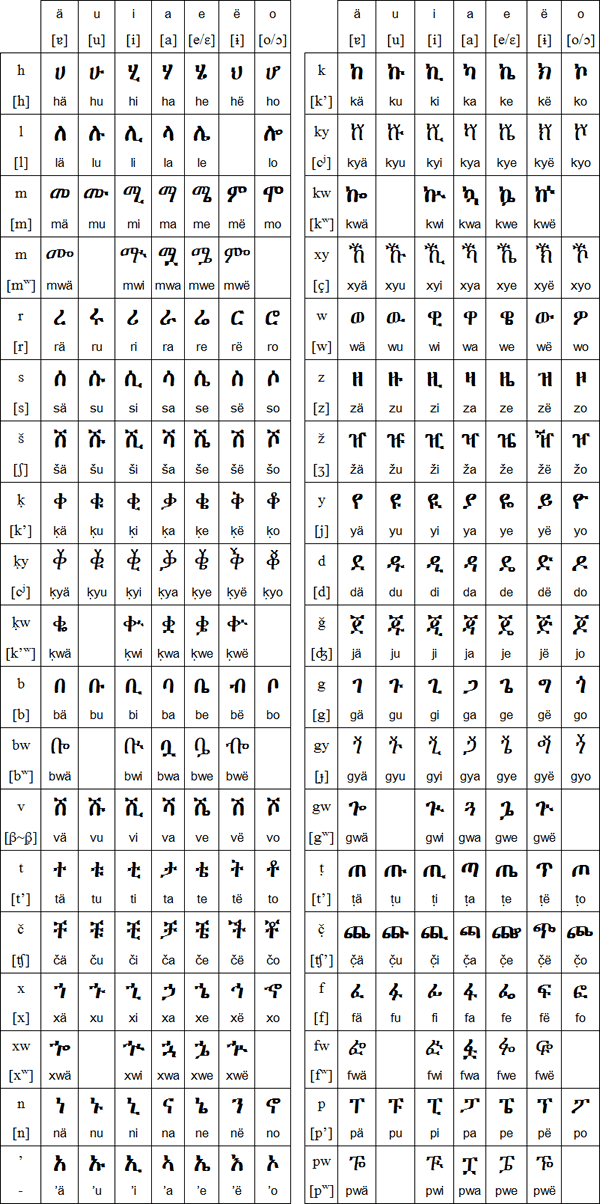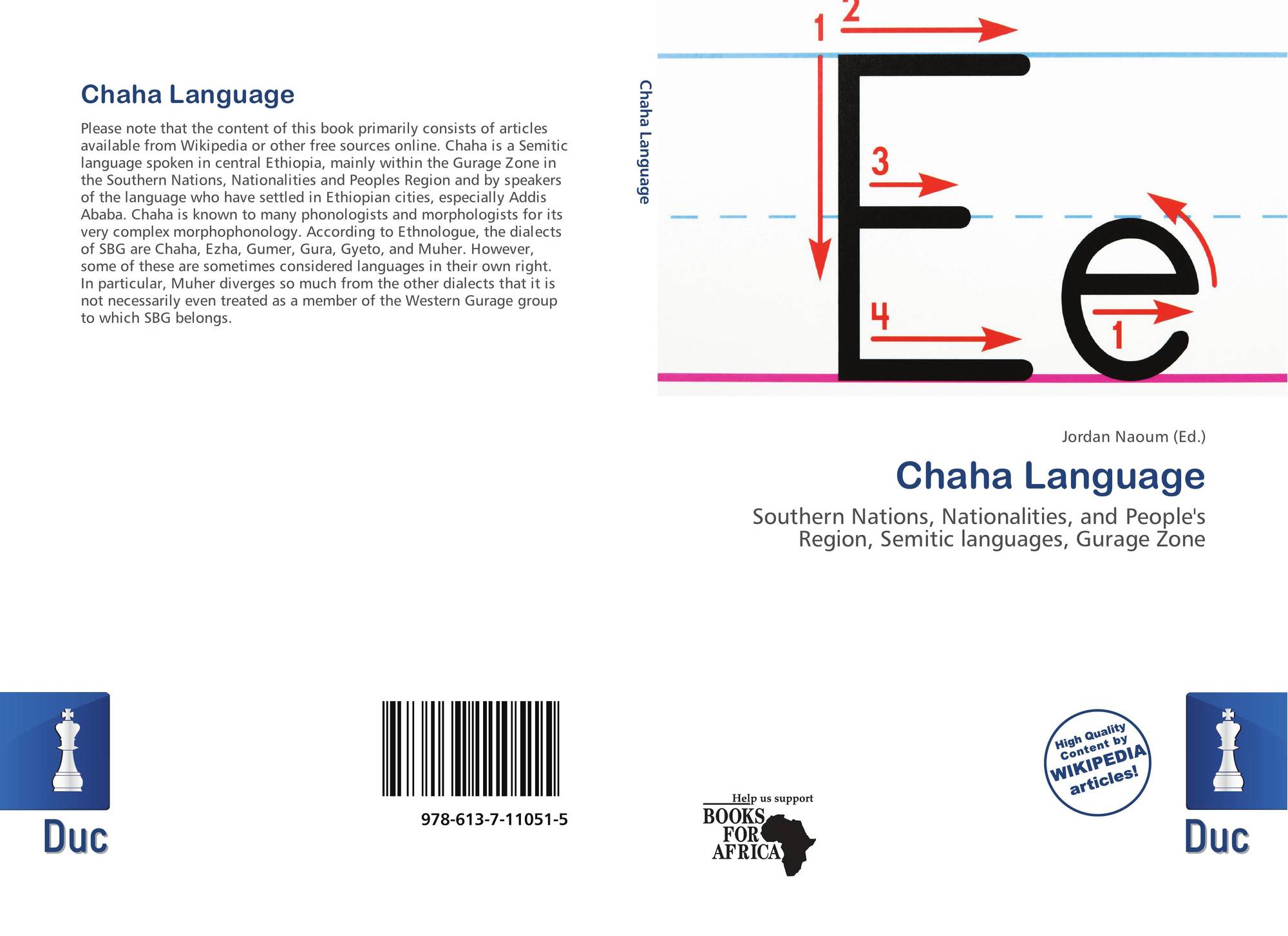Chaha language
Spoken in
- Afro-Asiatic languages Semitic languages West Semitic languages Äthiosemitische languages Südäthiosemitische languages Gurage languages Sebat Bet Gurage Chaha
-
This
Sgw
Chaha ( in Chaha and Amharic: Ćeha or čexā ) is a äthiosemitische language that is spoken in the Gurage Zone of the Southern Nations, Nationalities and Peoples Region.
The Chaha is known by phonologists and morphologists for its very complex morphonology.
Classification
Chaha belongs to the Sebat -bet Gurage language family (SBG ) and, according to Ethnologue, one of the seven dialects, some of which are often referred to as independent languages. This article focuses on the Chahadialekt who is better researched than the other dialects SBG. Unless otherwise indicated, are all examples of Chaha.
Sounds and letters
SBG has a fairly typical Phonemset for a äthiosemitische language. There are both ordinary as well as simple ejective voiceless and voiced consonants. However, the language is more palatalized labialisierte consonants and most other äthiosemitischen languages. In addition to the seven typical for these languages vowels SBG has the half open front ( ɛ ) and back vowel ( ɔ ). Some dialects have short and long vowel phonemes and some have nasalized vowels.
The tables below show the sounds of Chahadialekts in IPA symbols. The symbols of the Ethiopian inscription are in parentheses. How many phonemes there are exactly, is controversial due to the complex morphonology the SBG languages.
The following are the characters of the Ethiopian inscription will take the IPA characters.
Morphonology
In addition to the complexity of the verb morphology that is characteristic of all Semitic languages , SBG has a level of complexity because of the special relationship between the Konsonantenset in a verb root and its realization in a form of this verb or a noun derived. For example, some forms has " open " the verb root (as in most languages äthiosemitischen } from the consonants { kft } exists. Include all those consonants. For example, the third person singular masculine past, so " he opened ,". käfätä - m but if the passive is used, eg " it was opened ," two of the root consonants change: käf least play three different phonological processes in the SBG morphonology ʷ a role in the AEC. .
Devoicing and gemination
In most languages äthiosemitischen gemination, so Konsonantenlängung used in the grammar of verbs and to distinguish words. For example, the second consonant of three - consonant is doubled in Amharic verb root to display the Perfect: { sdb } " insult ", säddäbä " insulting ". In Chaha and some other dialects SBG the gemination is replaced by devoicing. For example, the verb root for is " insult " in SBG same as in Amharic ( with β instead of b ), but in the perfect tense of the second consonant is in the non geminierenden dialects t: sätäβä -m " insulting ". Only voiced consonants can be entstimmt: b / β → p, d → t, g → k, b ʷ → p ʷ, Ǧ → č, g ʸ → Ḳ ʸ, g ʷ → k ʷ, z → s, ž → š. The entstimmte / geminate form of r is n Others voiced consonants are not entstimmt.
Labialization
Some morphological processes lead to Labialization ( rounding ) of consonants. For example, the verb root of the dreikonsonantigen gkr { } " be straight " is derived adjective g ʷ ʷ ək ər "straight". Labial and velar consonants can be labialized: p → p ʷ a, b → b ʷ, β → w, f → f ʷ, k ʷ → k, K → Ḳ ʷ, g ʷ → g, x → x ʷ.
Palatalization Depalatalisierung
By some morphological processes consonants are patalisiert. For example, in the second person feminine singular of verbs in the past tense and the jussive / imperative palatalized consonant is one of the root (if possible): { kft } " open ", təkäft " you open " ( masculine ), təkäfč " you open " ( feminine ). Dental and velar consonants can be palatalized: t → C, T → C, D → Ǧ, s → š, ž z →, k → k ʸ, K → Ḳ ʸ, g → ɟ, x → x ʸ. r is patalisiert to y. In a morphological environment occurs the reverse process. The command form a class of verbs of the first consonant of the root is entpalatalisiert if possible. The verb " return " is actually the root consonants { ZPR }, for example žäpärä -m " he returned ," but that is ¼ to z entpalatalisiert in the imperative zäpǝr "Give that back! " ( To a man).
Allophones
The ratio of n, r, and l is complex. At least within the word stem can [n ] and [ r] as allophones of a single phoneme treat. The consonant is pronounced as [n ] in the initial position, when he was geminiert of r or when he finished the penultimate syllable of the word, otherwise it is a [r ].
- Nämädä -m " he liked ," Tae- rämädä -m " He was liked "
- Yǝ - βära " he eats " Bana -m " he ate " ( geminiert )
- Sǝräpätä -m " he spent time ", weighing sämbǝt " spend time" ( because of the following b is the n to m )
Banksira also called k as allophone of x and b as allophone of β
Font
SBG to write the Ge'ez or Ethiopic alphabet, which was originally developed for the now extinct language Ge'ez and is known today for its use in the Amharic and Tigrinya in. Although there are still relatively few in this language, three novels were published in Chahadialekt ( of clauses Sǝllase and Gäbräyäsus Haylämaryam ).
To represent the palatalized consonants that do not exist in Ge'ez, Amharic and Tigrinya, modified characters were introduced in the font that use, for example, via Asked corners. These were used for the first time published by the Ethiopian Bible Society New Testament, then in the entire Bible and are now generally used.









